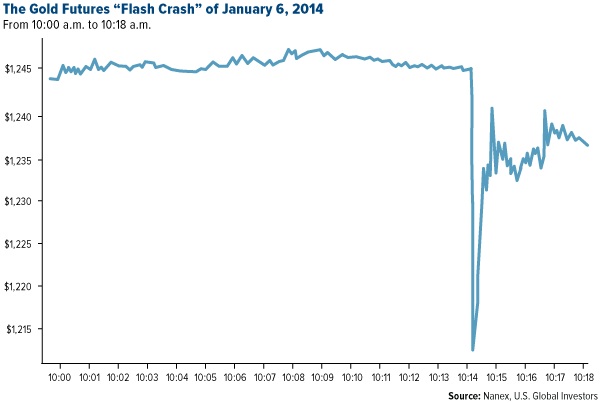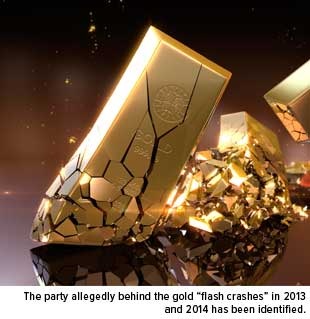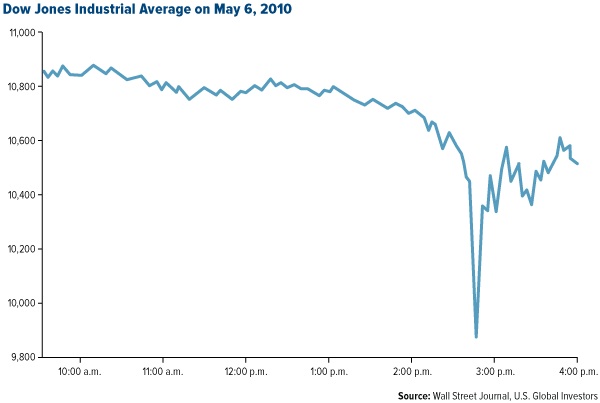There’s A Huge Disparity Between How Regulators Deal With Gold & Stock Market Manipulation
Gold futures were going bonkers in the fall of 2013 and early 2014.
On a weekly and sometimes daily basis, unbelievably massive gold contracts were coming on the market at non-peak trading hours, only to be withdrawn almost instantaneously. In one particularly alarming instance in January 2014, the yellow metal plummeted $30, from $1,245 an ounce to below $1,215 in as little as 100 milliseconds.

Whatever the cause of this behavior—“fat finger” errors, as some people suggested, or “quote stuffing,” as others suspected—markets were effectively shaken.
From the very beginning, we reported on these anomalies in a series of commentaries that read now like notes from a foxhole. In the September 13, 2013 edition of our Investor Alert, the USGI investments team wrote:
The bullion plunge this week sent the yellow metal breaking below the 100- and 50-day moving averages. Strange dealing patterns are adversely affecting the gold price. These dealings revolve around the “flashing” of massive gold contracts for sale to traders, at a time of day that there is normally little or no activity in the markets, and no news story being released.
Then, on October 25:
You can see massive trading volumes every day of over 5,000 contracts, all around the same time. On the first of October, as well as on October 10, there were massive trades of over 20,000 contracts. This amount represents well over two million ounces, or around $2.6 billion. It’s safe to say nobody has that amount of physical gold, apart from the big central banks, so these trades are being done by entities trading gold they do not have in a manner designed primarily to trigger stop loss orders.

And again, on December 20, 2013:
In recent weeks, there have been concerns among market participants and regulators that the process for establishing the price of gold may lend itself to insider trading and other forms of unfair dealing. The spot price of gold tends to drop sharply around the London evening fixing, or 10:00 a.m. Eastern. A similar, if less pronounced, drop in price occurs around the London morning fixing. For both commodities, there were, on average, no comparable price changes at any other time of the day. These patterns appear to be consistent with manipulation in both markets.
Although these “strange dealing patterns” eventually tapered off, it remained a mystery who or what was behind them.
Until now.
Last week, the CME Group officially accused Mirus Futures, a now-defunct brokerage firm, of failing to “adequately monitor the operation of its trading platform,” which resulted in “unusually large and atypical trading activity by several of the Firm’s customers.” This is what allegedly led to the disruption in price discovery in the gold futures market.
 What’s unclear is how culpable Mirus Futures really was in all of this. At the very least, it acted carelessly. Did its trading platform have a glitch, and if so, when did Mirus become aware of it? Was it deliberately trying to manipulate the gold markets? There’s no way we can know the answers to these questions. That Mirus has since been acquired by another brokerage firm would make any investigation into its intentions—if there were any to begin with—even more challenging for authorities.
What’s unclear is how culpable Mirus Futures really was in all of this. At the very least, it acted carelessly. Did its trading platform have a glitch, and if so, when did Mirus become aware of it? Was it deliberately trying to manipulate the gold markets? There’s no way we can know the answers to these questions. That Mirus has since been acquired by another brokerage firm would make any investigation into its intentions—if there were any to begin with—even more challenging for authorities.
What I find especially notable, though, is that the firm settled with the CME by paying a fine of only $200,000.
This is already a pretty paltry amount, considering how far-reaching its actions (or inactions) were. But when you compare the $200,000 penalty to what Navinder Sing Sarao faces, a huge disparity in the enforcement of such white collar crimes emerges.
Flashing the Stock Market
You might not be familiar with the name Navinder “Nav” Sarao, but it’s likely you’ve heard of the event he’s accused of orchestrating, thanks largely to Michael Lewis’s bestselling book Flash Boys. On May 6, 2010, Sarao, a 36-year-old British day trader, allegedly spoofed American markets using a familiar technique: mammoth-size orders were placed, only to be withdrawn right before execution. Price discovery broke down. In the brief timespan of five minutes, the Dow Jones Industrial Average was taken on a wild 1,000-point ride. Shares of Procter & Gamble fell to as little as a penny. Altogether, nearly $1 trillion in value vanished from U.S. stocks.

Two months after being arrested by Scotland Yard, Sarao now sits in a British prison on bail set at $7.5 million, his assets completely frozen. He awaits extradition to the U.S., where he will face multiple charges, including several counts of market manipulation, commodity fraud, wire fraud and more. According to the Department of Justice, “Sarao’s alleged manipulation earned him significant profits and contributed to a major drop in the U.S. stock market.”
The maximum sentence for all charges is 380 years in jail. Next to that, a $200,000 fine seems more reward than punishment.
You could argue that the upheaval that Sarao contributed to, if not singlehandedly caused, is more significant than the series of gold flashes that occurred in 2013 and 2014. Or that Sarao demonstrated nefarious intentions more unambiguously than Mirus Futures did. Still, the discrepancy is colossal and hard to ignore.
“Apparently regulators care much more about manipulation of the stock market than gold,” commented Ralph Aldis, portfolio manager of our Gold and Precious Metals Fund (USERX) and World Precious Minerals Fund (UNWPX).
This could be a problem. As long as rogue traders are convinced that their actions will go unchecked, the gold market could continue to be a target and the metal’s fair value remain under pressure. As I wrote last year in my whitepaper Managing Expectations: “We welcome the regulators to explore ways to manage these issues better and create both a fairer playing field and more transparent trading arena.”
But until gold is allowed to find its true, fundamental value, now might be a good time to accumulate. As always, I recommend that investors allocate 10 percent of their portfolios to gold—5 percent in bullion, 5 percent in gold stocks, then rebalance every year.
********
Please consider carefully a fund’s investment objectives, risks, charges and expenses. For this and other important information, obtain a fund prospectus by visiting www.usfunds.com or by calling 1-800-US-FUNDS (1-800-873-8637). Read it carefully before investing. Distributed by U.S. Global Brokerage, Inc.
Gold, precious metals, and precious minerals funds may be susceptible to adverse economic, political or regulatory developments due to concentrating in a single theme. The prices of gold, precious metals, and precious minerals are subject to substantial price fluctuations over short periods of time and may be affected by unpredicted international monetary and political policies. We suggest investing no more than 5% to 10% of your portfolio in these sectors.
The Dow Jones Industrial Average is a price-weighted average of 30 blue chip stocks that are generally leaders in their industry.
Fund portfolios are actively managed, and holdings may change daily. Holdings are reported as of the most recent quarter-end. Holdings in the Gold and Precious Metals Fund and World Precious Minerals Fund as a percentage of net assets as of 3/31/2015: CME Group Inc. 0.00%, Procter & Gamble Co. 0.00%.
All opinions expressed and data provided are subject to change without notice. Some of these opinions may not be appropriate to every investor. By clicking the link(s) above, you will be directed to a third-party website(s). U.S. Global Investors does not endorse all information supplied by this/these website(s) and is not responsible for its/their content.







 Frank Holmes is the CEO and Chief Investment Officer of
Frank Holmes is the CEO and Chief Investment Officer of 










